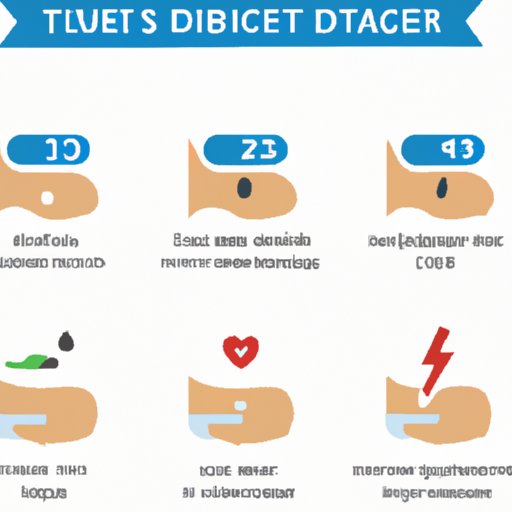
Introduction
Type 2 diabetes is a medical condition that affects millions of people worldwide. Early diagnosis and management are critical to preventing long-term complications and living a healthy life. In this article, we will discuss the various symptoms of type 2 diabetes and provide a comprehensive guide to early detection and management.
Scoping the Symptoms of Type 2 Diabetes: A Comprehensive Guide
Type 2 diabetes is a metabolic disorder characterized by insulin resistance, leading to high blood sugar levels. It differs from type 1 diabetes, which is an autoimmune disorder resulting in inadequate production of insulin. Type 2 diabetes is prevalent among adults, and its risk factors include unhealthy lifestyle choices, obesity, and family history. Common symptoms of type 2 diabetes include increased thirst and frequent urination, weight loss or gain, blurred vision, and fatigue. Less common symptoms include slow-healing wounds and frequent infections. In addition, type 2 diabetes increases the risk of other health concerns such as cardiovascular disease and diabetic retinopathy.
Understanding the Telltale Signs of Type 2 Diabetes: Symptoms to Look For
Type 2 diabetes can develop gradually, sometimes with no noticeable symptoms in the early stages. That’s why it’s essential to recognize the telltale signs early and monitor blood sugar levels regularly. Specific symptoms to look out for include feeling hungrier than usual, experiencing numbness or tingling in the feet or hands, and having dry skin or mouth.
The Warning Signs of Type 2 Diabetes: A Guide to Early Detection
Early detection of type 2 diabetes is crucial to preventing or delaying complications. Screenings and diagnostic tests can detect diabetes and prediabetes, providing opportunities for timely intervention. It’s recommended that adults over age 45, or those at high risk, receive a diabetes screening test. Family medical history and risk factors should also be discussed with a healthcare provider.
Living with Type 2 Diabetes: Common Symptoms and How to Manage Them
People with type 2 diabetes may experience various symptoms, such as neuropathy, diabetic retinopathy, and neuropathy. They can effectively manage these symptoms through medication, lifestyle changes, and seeking medical care when necessary. Effective management of blood sugar levels is crucial and can be achieved through eating a healthy diet, staying physically active, and monitoring blood sugar levels regularly.
Recognizing Signs of Type 2 Diabetes: Why Early Diagnosis is Crucial
The key takeaways from this article include recognizing the symptoms of type 2 diabetes, early detection, and the best ways to manage symptoms and prevent long-term complications. It’s vital for readers to take action, including consulting with a healthcare provider if they are experiencing symptoms or have risk factors for diabetes. Resources and support groups are also available for people living with or at risk for type 2 diabetes.
Conclusion
In conclusion, early detection, and management of type 2 diabetes are critical to living a healthy life. By recognizing symptoms and taking necessary measures to manage blood sugar levels, people with type 2 diabetes can prevent complications and improve their quality of life. We encourage readers to prioritize their health, practice self-care, and seek medical attention when necessary to manage their health and prevent type 2 diabetes.





